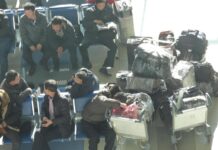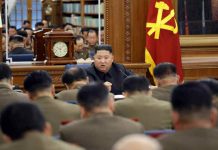Farms in some areas of North Korea have fallen far short of their production targets, which has led North Korean authorities to discuss the start of investigations to determine who is responsible for the shortfalls.
“The atmosphere in the farming sector is grave,” a source in South Pyongan Province told Daily NK last Thursday. “I’ve heard that a collective farm in Baeksong Village in Pyongsong couldn’t fulfill even half of their state-assigned quota this year.”
Since early this year, North Korea has staked its fortunes on improvements to its agricultural productivity and rolled out a large-scale campaign to increase production of foodstuffs. Yet this autumn’s harvest fell far short of expectations, leaving the country in a state of crisis.
The US Department of Agriculture (USDA) forecasted in its September “International Food Security Assessment 2022-23” that North Korea would see a food supply shortage of 1.21 million tons in 2022 – some 400,000 tons more than the DPRK’s average annual deficit of 800,000 tons. The USDA’s “October Rice Forecast” predicted that North Korea’s 2022-23 rice season will end with a final yield of just 1.36 million tons.
Additionally, the Korea Development Institute (KDI) predicted in its September “KDI Review of the North Korean Economy” that North Korea’s food insecurity could worsen from the end of this year and into 2023.
N. KOREAN OFFICIALS LOOK FOR PEOPLE TO BLAME FOR SHORTFALLS
Amid these dire international predictions about the country’s food situation, North Korean authorities are also sounding the alarm about the chronic fall in agricultural production.
“Recently, officials at city and county-level party organizations, government agencies, and agriculture management commissions in South Pyongan Province were mobilized to reassess the fall harvest numbers,” the source said. “The first assessment was held in early September, and it concluded that the problems with the harvest were caused by farms under-reporting their corn yields.”
The North Korean government purchases a large portion of the crops produced on collective farms at prices below market value. Once the government purchases grains, there is not enough left behind for collective farms to distribute to their farmers. As such, collective farms frequently under-report their output to the government so they can feed their farmers.
The recent assessment of corn yields found that collective farms have reported yields lower than the accurate amount of crops harvested. This suggests that collective farms in the country have been under-reporting their crop yields this year as well.
In some areas of North Korea, the authorities have moved to discuss the start of investigations into collective farms.
“Recently, at a meeting of the South Pyongan Province provincial party committee, officials discussed carrying out investigations into county-level collective farms,” the source said. “They appear intent on pinning all of the responsibility for the drop in production on the farm managers.”
The decline in agricultural production is undeniably the result of a shortage of agricultural inputs like fertilizer and pesticides, drought, and flood damage. However, government discussions on conducting assessments of collective farm managers appear to be aimed at blaming farm managers for the drop in production.
Many in the agricultural industry are complaining about the government’s move to place the blame on falls in production entirely at the feet of collective farm managers, the source added.
Translated by Rose Adams.
Please direct any comments or questions about this article to dailynkenglish@uni-media.net.



















